Landblog Main
previous archive
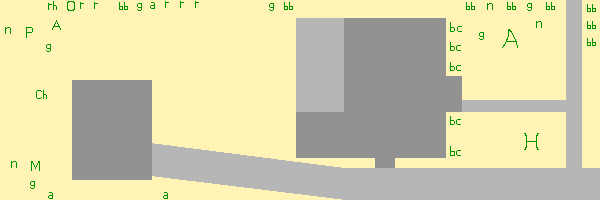
Spring Planting -- 8 April 2012 -- On April 4 my plants from Raintree and St Lawrence arrived on the same day, and yesterday I finished putting them around my house. Above is a precise map of the yard, made with mtPaint. Each pixel represents three inches, and the whole lot is 50 by 150 feet. On the right side, in the planting strip by the street, "bb" represents lowbush blueberry, one Friendship and one Northblue. The large H is a 50 year old hawthorn tree that came with the house. The pink flowers are pretty but it's blocking my southeast light. The large A is a last minute order that hasn't come yet, an Orleans Reinette apple from Southmeadow Fruit Gardens. It seems to be listed more than any other apple as the best tasting in the world, but it's only hardy to zone 6. Thanks to climate change, I now feel safe growing it in the city, but I still wouldn't risk it 800 feet higher on the land.
Along the front of the house are five black currants, three Consort and two Ben Lomond. I'm trying to pick the ones with the strongest black currant flavor, and I've heard Crandall is also excellent. I've also heard currants and gooseberries don't mind getting morning light and no afternoon light, so that's why they're on the east side of the house.
In the back yard behind the garage, the M is an Illinois Everbearing mulberry. It's going to be a big tree, so I was originally going to put it in the northwest spot. But there are overhead lines there, so I decided to put it where it can reach its full size, even though it's going to shade my other trees. Above the mulberry is a Bali tart cherry, known as Evans in Canada. I've read that it doesn't quite match the flavor of Montmorency but it's better in every other way. Tart cherry is just about my favorite fruit. I don't even like sweet cherries. Next up, the P and A are a Contender peach and a Puget Gold apricot, both on Lovell rootstock. Because the roots think they're the same plant, there will be no below-ground disadvantage to planting them so close. Contender is the best-flavored short-season peach, but I've also read that it's a terrible keeper, and it might be worth sacrificing some flavor to grow Reliance instead.
The three small a's are Nero aronia, also known as black chokeberry. The berries are astringent, which is something different from sour or bitter, but otherwise they taste great, and I haven't grown any other berry bush that can survive so much abuse. Aronia is a tank! The O is an oregon grape bush that was already there. The rh is a rhubarb start (thanks Rachael for donating it), and the r's are Caroline raspberries, which I got as free bonus plants from Raintree.
Also today I made my first 2012 trip up to the land. As always on the first trip, I parked at the edge of the pavement and walked the two miles of dirt roads. We had a warm winter, but it was the rainiest March in recorded history, and the roads are worse than I've ever seen them, with ruts that would swallow a regular car tire up to the axle. There were some large 4wd trucks moving barely faster than I was walking, but I won't be able to drive in until somebody comes through with a grader. Anyway, everything up there looks fine, except that a moose ate all of last year's growth off my two favorite trees, the Ivan's Beauty and the larger Montmorency cherry. I planted a single Ben Lomond currant in a hole I dug last fall, which turned out to be just at the edge of the snow. Because I won't try to go up again for at least two weeks, I piled a bunch of snow and ice on the uphill side.
Blueberries and Dandelions -- 27 April 2012 -- A few days ago I was at Fred Meyer and noticed that potted blueberries were on sale for $7. It would have been difficult to carry more than two on my bike, so I drove the truck down and bought six. The varieties are Bluecrop, Bluegold, Northblue, Duke, Reka, and Toro. I'm not sure why I bought a Northblue since I already have one, but I stuck it in the planting strip, put three others along the north edge of the front yard, and two in back. The image above has been updated, and some of the plants look like they'll make berries this year.
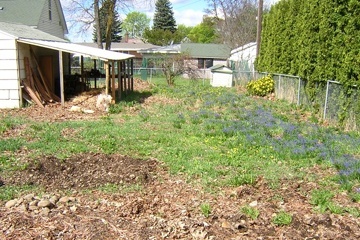 In other yard news, everything is thriving except the peach, apricot, and mulberry, none of which have put out leaves yet, and the mulberry seems to be dying back almost to the ground. Here's a photo of the back yard in spring. That yellow bush is the oregon grape in full flower, and the blue-purple flowers are Muscari, or Grape Hyacinth, apparently the only thing planted by a previous resident that can survive total neglect. They look nice and make nectar for insects, so I'm going to let them continue to fill in the gaps. Near the bottom of the photo is an area I sheet mulched with leaves and cardboard, and along the bottom are my salad greens. Why go to the trouble to plant lettuce or kale when dandelions volunteer, and are more nutritious? Well, because they're bitter. But I can fix that by eating them with sweet potato chips.
In other yard news, everything is thriving except the peach, apricot, and mulberry, none of which have put out leaves yet, and the mulberry seems to be dying back almost to the ground. Here's a photo of the back yard in spring. That yellow bush is the oregon grape in full flower, and the blue-purple flowers are Muscari, or Grape Hyacinth, apparently the only thing planted by a previous resident that can survive total neglect. They look nice and make nectar for insects, so I'm going to let them continue to fill in the gaps. Near the bottom of the photo is an area I sheet mulched with leaves and cardboard, and along the bottom are my salad greens. Why go to the trouble to plant lettuce or kale when dandelions volunteer, and are more nutritious? Well, because they're bitter. But I can fix that by eating them with sweet potato chips.More Yard Bushes -- 23 May 2012 -- The weekend before last I rode my bike to the Lawyer Nursery annual clearance sale and bought 16 more plants: eight goumis, four nanking cherries, and four blue elders. Goumi (Elaeagnus multiflora) is a nitrogen fixing berry bush, which increases the production of the plants around it. I put six in the yard and two up at the land. Nanking cherry is a sour bush cherry. As with goumis, I've never tasted them, but I figure I'll like them since I love sour cherries, and they're cheap. I put all four in the yard, and I put all four blue elders up at the land. The yard map below has been updated with "g" and "n" for the new plants.
The yard is 800 feet lower than the land, with better soil, and I'm able to do a lot more watering. These factors have combined to make a huge difference. I'm going to get more blueberries and black currants in my first year in the yard than in all years at the land combined, and the apple tree has already put on more growth than a typical apple up north puts on in a year.
I'm letting the yard go wild, with giant dandelions everywhere. My neighbors haven't said anything yet. And in the front yard I'm eradicating every trace of grass. My eventual plan is for the entire yard to be grassless. It's a useless plant unless you have animals that graze it.
Epic Plumbing -- 7 June 2012 -- This house has been a plumbing challenge from the beginning. Even before I bought it, I knew from the HUD inspection that the lines didn't hold water. There turned out to be a big leak from the front outside hose faucet, a moderate leak from the dishwasher connection under the kitchen sink, and several minor leaks. When I got back from my winter tour, I noticed a leak in the basement where a PVC pipe connected to a brass shutoff valve. Rather than fix it, I decided to tear out all the PVC supply pipes in the basement and replace them with soldered half inch copper.
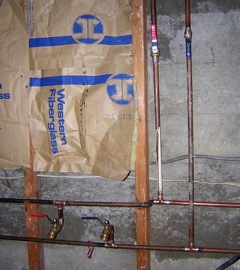 This was a much bigger project than I expected. Today I did a count, and I used 41 pipe pieces, 45 copper and brass fittings, and ten valves. There were ten threaded connections, four compression fittings, and 86 solder joints. That equals exactly 100 places where there could be a leak, and that's not counting the connections from the pipes to the faucets. I used all ball valves and quarter-turn valves, because I've seen too many multi-turn valves where you crank them shut as tight as you can and they still leak.
This was a much bigger project than I expected. Today I did a count, and I used 41 pipe pieces, 45 copper and brass fittings, and ten valves. There were ten threaded connections, four compression fittings, and 86 solder joints. That equals exactly 100 places where there could be a leak, and that's not counting the connections from the pipes to the faucets. I used all ball valves and quarter-turn valves, because I've seen too many multi-turn valves where you crank them shut as tight as you can and they still leak.In the photo you can see the master shutoff for the basement plumbing at the top, and two more ball valves for the washing machine at the lower left. I wanted them color-coded, and I noticed that Home Depot ball valves are red, and Lowes ball valves are blue. So for the master shutoff, I got one of each. The laundry valves are both from Lowes -- so why is one of them red? Last summer I installed two red Home Depot ball valves under the kitchen sink, and it occurred to me that I could just switch the plastic covers on the handles. They don't come off easily, but I managed to push them off by jamming in an old hacksaw blade.
If you look closely, you can see a little jog in the hot line to get it behind the cold line. This is not something you have to think about with PVC pipes, because they're so flexible. With copper, if you turn a corner and the pipes cross, you have to do a lot of extra work to get them around each other. It's much easier to design the system so that at every corner, the pipe that starts on the outside stays on the outside. The PVC pipes had cold on top and crossed over each other in several places, but I noticed that the crossovers would all cancel out just by switching the main pipes so that hot was on top. So this was the only spot where I had to get one pipe around another.
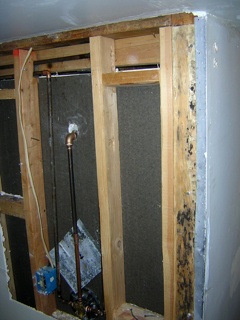 Here's a photo with another complication. This is the back of the shower, and if you look in the upper right you can see two holes I drilled in the wall. This was the easiest way to feed the pipes into the wall. Otherwise I would have had to tear the whole wall apart, drywall and studs, or else use a bunch of small pipes connected together. Even doing it this way, I had to use two sections for each pipe, because the wall opposite the holes is only 37 inches away, so anything longer could not get in position to slide into the hole.
Here's a photo with another complication. This is the back of the shower, and if you look in the upper right you can see two holes I drilled in the wall. This was the easiest way to feed the pipes into the wall. Otherwise I would have had to tear the whole wall apart, drywall and studs, or else use a bunch of small pipes connected together. Even doing it this way, I had to use two sections for each pipe, because the wall opposite the holes is only 37 inches away, so anything longer could not get in position to slide into the hole.Also notice the scrap of sheet metal behind the pipe that feeds the shower head. Originally it was a bit higher and I jammed a brush in to prop it up right behind the solder joint in the center of the pipe, so the torch wouldn't burn down the house. I did a lot of bending of that piece of metal in various places, and also used some other pieces. Anyway, there's a reason for that joint. I had pipes long enough to go the whole way, but there are threaded fittings at the top and bottom, and you can't solder right next to a threaded fitting or you'll burn the tape. That means I would have to make the pipe ahead of time, with the two copper solder-to-thread fittings at the top and bottom, and then screw them both in. But getting the brass elbow at the right height would require difficult measuring, and worse: when tightening them, I would have to stop tightening at exactly the point where the brass elbow faces the shower. This would probably require one of the two thread joints to be either too tight or two loose. Making a solder joint in the middle allowed me to tighten the top and bottom just the right amount, then solder them together.
Yesterday I got all the end pieces on and turned on the water. First the hot (which is not actually hot because I have the water heater off) and there was only one leak in a compression fitting to an under-sink valve. I tightened it harder, checked all the solder joints, and thought, wow, soldering is easy! Then I turned on the cold water and there were three leaks. One of them the water was gushing out of, so I immediately turned the valve off, and then put a jar under the toilet valve, which was lowest, to drain the pipes. But draining the pipes is not that easy. You need another opening somewhere to let air in, and even then, there are low places in horizontal pipes where the water sits. I learned to open the toilet valve and blow into the washing machine valve to get more water out.
Sometimes a leaky solder joint can be fixed by just reheating it and adding more solder, but I found that sometimes I had to take it apart, make sure all the surfaces were covered with solder, and put it back together. (Yes, I used a steel brush to rough up all the copper and also used flux paste.) There was a stubborn T-fitting behind the toilet tank, and I had to remove the tank to get a good angle on it.
Also I was having a problem with the torch. A master solderer will never lose a drip, but I'm a beginner and was dripping a lot, and because I had to hold the torch at all kinds of angles, inevitably there would be a drip when the nozzle was directly underneath, and the solder would get stuck in there. You'd think it would melt, but down where the gas is just starting to combust, it never gets hot enough. Eventually so much solder was clogging the nozzle that my blue flame was coming out in a messy spray. Would I have to buy a second torch just to melt the solder out of the first one? This morning I decided to try the toaster oven. I unscrewed the nozzle and stuck it in at 500 degrees, and after ten minutes, the solder was melted and I grabbed it with pliers and knocked it clean.
I also found out that leaks can sneak up on you. Today, 20 hours after being pressurized, one of the joints in the hot water line started dripping, so I drained the hot line and gave it a blast and more flux and solder. I know that "silver solder" is 96 percent tin, but I've been putting more on the floor than in the joints and I wonder if it's worth collecting.
Update, 1 July 2012: After I wrote this, the leaky solder joints kept coming. I think I've got them all fixed now. In every case, when I took the joint apart, there was a bit of pipe where the solder had not stuck. My advice: if you're using old pipes, it is not enough to brush them shiny and cover them with flux. New pipes should be brushed and fluxed, and old pipes should be pre-tinned all the way around to make absolutely sure the solder is going to stick.
Also I figured out a trick for finding little leaks. When you go to bed, shut off the master water. In the morning turn it on, and if you hear any water flowing through the valve, then you've lost pressure somewhere in the system. Because of the intermediate shutoffs in the top photo, I didn't have to shut off water to the whole house.
So the copper pipes were the second big plumbing project this spring. The first one was installing a hot water heater. The house has a working gas water heater, which previous owners installed in 2005. I could see where there was once an electric water heater, in the perfect spot right next to all the places in the house where you use hot water. They took it out, and ran 3/4 inch copper pipe all the way to a far corner of the basement, where there was a place to vent a gas heater, and then all the way back. This means I almost had time to go to the store and back waiting for hot water to come out of the faucet. I was doing dishes by heating up water on an induction burner because it was faster than waiting for hot water to come out of the sink.
So I decided to buy a new electric water heater and put it back in the right place. I know that gas is cheaper than electricity, especially right now, but an electric heater is more efficient because it doesn't vent heat outside the house. Also, pilot lights are evil, because they burn a lot of energy where it's not needed. So the electric heater might cost me a bit more, but it will also make an insignificant scratch in climate change, and most important, I'll get hot water fast.
I considered a tankless heater. They sound great in theory, because you're not wasting energy keeping a tank of water hot. But the more I read, the worse they sounded. The temperature is uneven, they use more energy if you live with someone whose showers are limited by the hot water running out, and worst of all, the heating elements tend to mineralize in only a few years if you don't pre-filter the water. And the newer tank heaters have very good insulation. I decided to get a 12 year 40 gallon model from Home Depot. Some people will tell you that 12 year heaters are identical to 6 year heaters and you're just paying for the warranty. They're talking out their ass. Consumer Reports bought some 6, 9, and 12 year heaters and cut them up, and the ones with longer warranties are built with better materials.
Anyway, installing the new heater was easy, because the pipes were already set up for where I was going to put it. The only tricky thing was how to connect it. I looked on some forums, and most people say the braided steel connectors are crap and the hot water will ruin the tubes inside. There was a regional faction that said you should not use flexible connectors at all but hard pipes the whole way. I decided to go with flexible corrugated stainless steel connectors, which were less than $10 each at Lowes. Here's a photo.
End of Summer Roundup -- 17 September 2012 -- I've done almost nothing on the land this year. The two goumis I planted are doing fine, and three of the four blue elders died. It was the best year ever for thimbleberries and blackberries, and the worst for aronia. Last fall someone donated a bunch of black walnuts in their shells and husks, and I buried them shallowly along the road in the southeast corner. This summer I noticed that three or four of them had sprouted into tiny trees, and I gave them some compost and extra water. We'll see how many make it through the winter. Also this year I did almost no watering of the established plants, and none of them died.
 Back at the house, after the plumbing project, I hung some drywall and started another project that I'll write about later. In the front yard I've managed to eradicate all the grass, and I harvested most of the dandelions. My neighbors must have thought I was weeding, but of course dandelion is one of the most useful plants in the world. It's a great dynamic accumulator, the flowers are like candy (if you don't eat actual candy), the spring leaves are good in salads, and in summer I dig up the roots. The digging is the easy part. Then it's a huge chore to clean them all in the sink and cut them thin enough for drying. Then it's easy again to leave them on a tray in the sun. There were some weeks when dandelion roots were my main vegetable.
Back at the house, after the plumbing project, I hung some drywall and started another project that I'll write about later. In the front yard I've managed to eradicate all the grass, and I harvested most of the dandelions. My neighbors must have thought I was weeding, but of course dandelion is one of the most useful plants in the world. It's a great dynamic accumulator, the flowers are like candy (if you don't eat actual candy), the spring leaves are good in salads, and in summer I dig up the roots. The digging is the easy part. Then it's a huge chore to clean them all in the sink and cut them thin enough for drying. Then it's easy again to leave them on a tray in the sun. There were some weeks when dandelion roots were my main vegetable.For the last two weeks I've been trying to put a bed together. Beds are challenging! If they were easy, nobody would spend a thousand dollars on a mattress. Personally I sleep fine on a futon on the floor, and that's what I've been doing all summer, but I have to flip it over and prop it up every morning to air it out, so it doesn't get moldy like the last futon which is now composting in the future strawberry patch. Bodies put out a lot of moisture in the night, which is why so many "futons" are modern mattresses with inner springs and layers of foam. But it's hard to make a spring mattress that's not too soft, and some foam is toxic, probably not in mattresses but I still don't trust it. I wanted an all-cotton futon, on a regular bed frame, with some way to let it breathe.
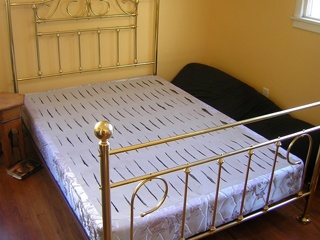 Normally cotton futons are put on wooden slats, but I can always feel the gaps between the slats and I don't like it. An eight inch futon might be thick enough to not feel the slats, but again it would be expensive and damn heavy. I also considered putting a bunch of narrow slats with thin gaps across a bed frame, but then the bed would still be too low, unless I used even more wood to raise the slats. In the photo you can see what I did instead. First I went on craigslist and got a nice bed frame for $100, then I dropped another $100 on an all-cotton five inch futon from Amazon, then I lurked on craigslist until I got lucky and snagged a box spring for free. A box spring has thick padding on top that breathes better than the floor, but probably still not good enough. So I spent this morning with a utility blade and a pair of scissors, cutting 126 slits in the gaps between the wires, so the wires are still padded but the futon might get enough air to stay dry. I should know by spring.
Normally cotton futons are put on wooden slats, but I can always feel the gaps between the slats and I don't like it. An eight inch futon might be thick enough to not feel the slats, but again it would be expensive and damn heavy. I also considered putting a bunch of narrow slats with thin gaps across a bed frame, but then the bed would still be too low, unless I used even more wood to raise the slats. In the photo you can see what I did instead. First I went on craigslist and got a nice bed frame for $100, then I dropped another $100 on an all-cotton five inch futon from Amazon, then I lurked on craigslist until I got lucky and snagged a box spring for free. A box spring has thick padding on top that breathes better than the floor, but probably still not good enough. So I spent this morning with a utility blade and a pair of scissors, cutting 126 slits in the gaps between the wires, so the wires are still padded but the futon might get enough air to stay dry. I should know by spring.